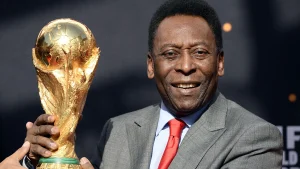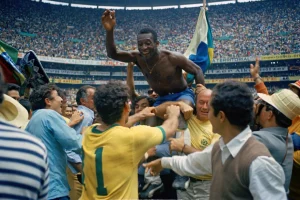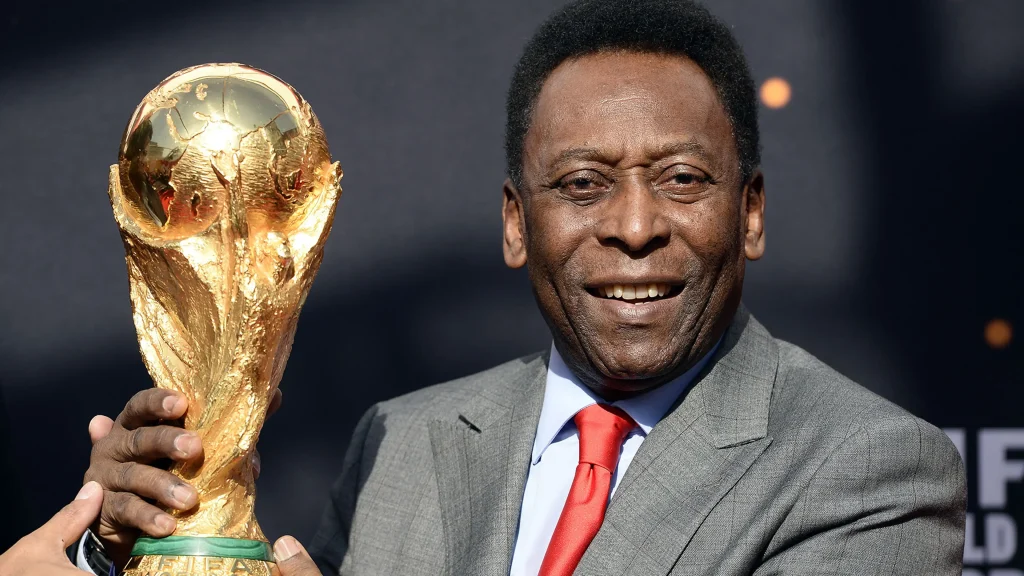
Even if the International Olympic Committee hadn’t named him Athlete of the Century in 1999, Pele’s status as one of the greatest of all sportspersons would have been unchallenged. Integral to two of the greatest teams of all time, his influence extended far beyond the playing field.
If you happened to be in some remote corner of the world, and you mentioned the name “Edson Arantes do Nascimento”, the chances were that you would be greeted with blank stares in return. Instead, if you used the nickname that the same man was popularly known by, Pelé, those same stares would usually be replaced by smiles of recognition.
For more than two generations of Brazilians, and football lovers from elsewhere, that name opened doors and hearts wherever you were on the planet. Even in the days before the world wide web, Pele and the late Muhammad Ali were truly global icons. It didn’t matter if you were in Madrid or Marrakech, Kolkata or Kingston, the king’s name was a conversation starter.
Though no one under the age of 60 had even seen him play, the teenage wonder who exploded into the global consciousness with his goals at one of the first televised World Cups (Sweden, 1958) – before becoming one of the senior statesmen of perhaps the greatest international team ever (1970) – transcended the sport. As with Jesse Owens, Ali and Joe Louis, Pele’s role in the battle that athletes of colour had to fight for self-respect shouldn’t be underestimated.
Most of all, though, Pele was a wonderful footballer, at the heart of two sides that made Brazil the ‘neutral’s team’ for generations. It wasn’t just that they won three World Cups between 1958 and 1970. It was the manner in which they won them – with matchless flair, scoring 11 goals apiece in the knockout rounds in both 1958 and 1970. Pele contributed six of them in 1958, including a hat-trick against France, and opened the scoring in the 1970 final against Italy.
By then, he was no longer just a goal-scorer. His clever runs, movement and passing were central to Brazilian victories over Peru (4-2), Uruguay (3-1) and Italy (4-1). Jairzinho scored in every round, Roberto Rivellino’s hammer of a left foot contributed three goals, and Tostao scored twice, but most observers had Pele as their player of the tournament for the manner in which he took it upon himself to tease defenders out of position so that his teammates could apply the finishing touches. The four goals he scored were a bonus.
If anything, it’s the near misses – especially the outrageous dummy against Uruguay in the semifinal, and Gordon Banks’ miraculous save for England – that people recall more than the goals. And has there ever been a more famous assist than the perfectly weighted pass to Carlos Alberto for Brazil’s fourth in the final, rightly regarded as the greatest team goal ever?
For the Latest Sports News: Click Here
As with any popular icon, it became fashionable after a while to try and find feet of clay, whether it was in his politics, relationships or public utterances. Pele never claimed to be perfect, nor did he anoint himself as a role model, but there was always a vocal minority that existed merely to run him down and build up his rivals.
In Brazil itself, he was probably not even the most loved footballer of his generation. Mane Garrincha was the tragic hero, with his deformed feet, incredible trickery on the ball and tumultuous personal life. His death from alcoholism before he turned 50 merely embellished the legend. But to compare one with the other was just daft. Both men would have told you that they were at their best when they played together. Certainly, Brazil were unbeatable when they did.
Diego Maradona, Lionel Messi and Johan Cruyff, who supplemented his achievements as a player by becoming the most influential of coaches, will all have their adherents when it comes to a debate about the greatest footballer of all. But it’s safe and entirely accurate to say that no one ever expanded football’s footprint like Pele did. Despite the USA’s participation in the 1930 and 1950 World Cups – they upset England 1-0 in the 1950 edition – the sport was an afterthought in North America, lagging behind basketball, American Football, baseball and even ice hockey when Pele went to play for New York Cosmos in the North American Soccer League (NASL) in the 1970s.
The two years he spent there were instrumental in the growth of the sport. The NASL may have folded in the 1980s, to be replaced by Major League Soccer (MLS) in the 1990s, but the seeds had been sown for a World Cup to be hosted in 1994. For three decades now, the USA’s women’s team has set the standards for the rest of the world to emulate. The men’s team have challenged Mexico for top-dog status in the CONCACAF federation since the late 1980s.
Even as parents hesitate to let their kids play American Football or ice hockey, because of evolving research surrounding brain injuries, and basketball remains the preserve of the super-tall, football has become the No.1 participation sport for young boys and girls in North America. It’s no exaggeration to say that such a scenario wouldn’t have been possible without Pele’s stint in the NASL.

But as influential as his time with Cosmos was, the other defining characteristic of Pele’s career was his loyalty. Having first played for Santos as a precocious 15-year-old, Pele would spend his entire top-flight career there, moving to New York only long after his days as a Brazilian international were over. During the nearly two decades that he represented Santos, he would have lost count of the number of blank cheques that came his way. Every top club side in the world coveted him. But Pele never left the small industrial city on the outskirts of Sao Paulo, scoring over 600 goals for them in official matches, and another 500-odd in exhibition games around the world.
At one point in the 1960s, Santos’s all-white kit was as famous as Real Madrid’s, with the bar-code away version equally well recognised. Maradona considered Boca Juniors the club of his heart, but his best years were spent at Napoli in southern Italy. Cruyff came through the ranks at Ajax but left for Barcelona while still in his prime. One of Zinedine Zidane’s greatest regrets was not being able to play for his beloved Olympique de Marseille, while Messi has yet to play a senior game for Newell’s Old Boys, the team of his childhood dreams. Pele’s devotion to the Santos crest is one of the notable sidelights of his remarkable story.
How will we remember this greatest of sportsmen? The prodigy with the coconut haircut in 1958, scoring awe-inspiring goals before celebrating with the exuberance of the teenager that he was then? The legend kicked out of contention in 1966 by some brutal tackles? Or the calm but joyful playmaker around whom a second great Brazilian side was built in 1970? Mario Zagallo, the coach in 1970, had been a player in 1958, but on the field, Pele was the only link to Brazil’s first World Cup win.
He was also one of the very few great sportspersons to visit India while still active, coming to Kolkata with New York Cosmos in 1977. That visit, and another nearly four decades later in 2015, cemented his place in the affections of Indian football lovers. For a generation of fans who grew up in the 1950s and ’60s, it was always Pele and then daylight. Many of them have also passed on now, but the stories they shared with their kids and others remain.
Like Pele, those are immortal.
Also Read: “I am the one and only!” – Pele




